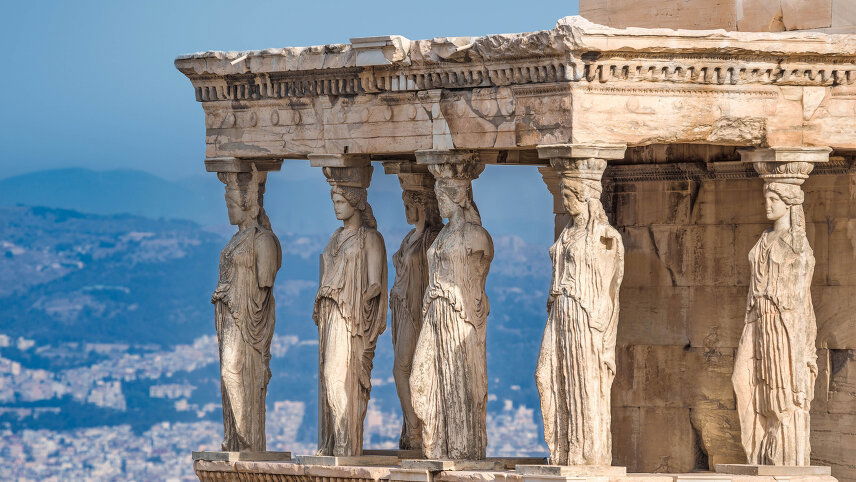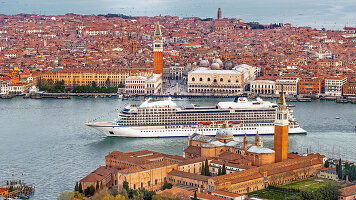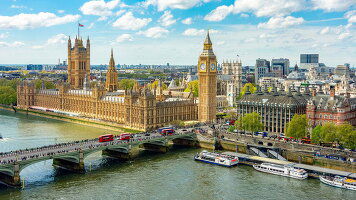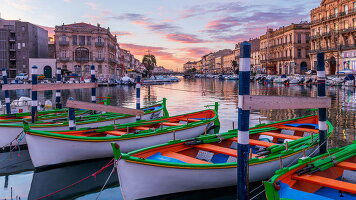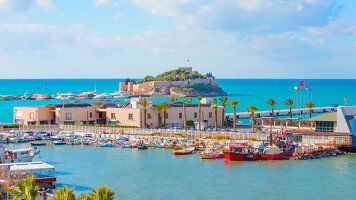Overview
Itinerary
Venice is a wondrous patchwork of graceful piazzas, tranquil canals, artful footbridges and Gothic splendor. This is an impossibly romantic place, made dreamier still by a serene gondola ride. To view its riches up close, walking is best. All things Venetian begin in St. Mark's Square where its elegant campanile, or bell tower, rings over the rooftops, and the Byzantine-Gothic St. Mark's Basilica seems to preside over all. Beyond St. Mark's and away from the crowds, Venice is a hushed and fascinating city to explore on foot, with medieval echoes marking your every step.
The Venetian Republic ruled Adriatic waves for a millennium. During the 8th century as the Roman Empire began its decline, many Europeans fled to Venice. Merchants put their skills to use, and the city-state was soon thriving. Along the city's Grand Canal, more than 50 palazzi line its banks featuring buildings influenced by Byzantine and Islamic architecture, reflecting Venice's powerful trading network. The first vaporetto traversed the Grand Canal in 1881; alongside the gondolas, these iconic Venetian water buses are at the heart of Venice's transport network.
Built around the Roman Palace of Emperor Diocletian, Split is one of Croatia's oldest cities. Its promenade commands majestic views over a bay and the Adriatic Sea. Despite evidence of Split's origins in the 6th century BC, the city is traditionally considered over 1,700 years old—counting from the construction of the palace. Its well-preserved remains have been seamlessly assimilated into the modern city. An Ethnographic Museum is found at the palace's heart and shops line the passageways of its ancient basement. Diocletian's ancient mausoleum is now a stunning cathedral.
Dubrovnik is a historic jewel, with its spectacular Adriatic setting, 12th-century medieval streets and incredibly preserved structures. So stunning is its Old Town, the playwright George Bernard Shaw famously called it “paradise on Earth.” It is all spectacularly surrounded by a towering medieval wall. Inside, the ancient city's Stradun is lined with authentic stone houses. The peaceful 14th-century Franciscan Monastery and Apothecary, housing the world's oldest working pharmacy and fine collection of Renaissance paintings, provide insight into the ages.
Kotor is Montenegro's picturesque capital set amid glorious mountains and dramatic scenery. Towering cliffs soar above the narrow Kotor ria —a submerged river canyon often called Europe's southernmost fjord. Kotor is also home to one of the Adriatic's best-preserved medieval Old Towns. The charms of this red-roofed city are endless, from the mismatched towers of its Romanesque cathedral to its narrow streets. Its stunning Venetian walls were built in 1420, remnants from Kotor's nearly 300 years as a province of the Venetian Republic.
Corfu has a rich history shaped by conquerors and by royalty seeking tranquility. Corfu's Old Town and Fortress—fashioned by the once powerful Venetian Republic—comprise a UNESCO World Heritage Site. Its narrow warrens lead to one of Europe's largest public squares and a lovely promenade once exclusively reserved for the local aristocracy. Everywhere, magnificent coastal views unfold and scenic byways lead to history-rich enclaves, from the archaeological site of Paleopolis and the stunning Vlacherna Monastery to a former Greek royal villa.
Katakolon is huddled around a pretty little harbor dotted with colorful fishing boats. Nearby, the fertile valleys of the western Peloponnese are a bounty of olive groves, vineyards and orchards, and lead to the legendary city of Olympia. The well-kept ruins here transport visitors back to the days of the earliest athletes who competed for nothing less than the favor of the gods. The remains evoke the glory of the Games, and the Olympia Archaeological Museum features statues that once overlooked the site.
Athens has been called the “birthplace of democracy.” Its legacy looms large from atop Acropolis Hill, the pinnacle of ancient Greece. This open air museum is an astonishing repository of once-mighty structures. From its colonnaded Parthenon—more than 2,600 years ago—revered Greek philosophers like Plato and Aristotle formulated new ideas of government and debated its role in civic life to captivated audiences. Remnants of spiritual life are also here in the several temples to Athena and Zeus.
For a more intimate experience of Athens, the charming Plaka District invites guests with its labyrinth of cobblestone lanes. Neoclassical architecture lines the narrow streets of the “Neighborhood of the Gods,” so named for its location. Browsing its shops or simply perusing its nooks and crannies are pastimes favored by visitors and locals alike. This historic area is the ideal setting in which to enjoy traditional small plates of mezes and a sip of ouzo.
One of antiquity's best-preserved cities, Ephesus offers an unparalleled look into the lives of the ancients. Many of its ruins have endured from the time Ephesus was one of the largest metropolises of the ancient world. Excavations reach back to the 10th century BC, when this city hosted one of the Seven Wonders of the Ancient World—the Temple of Artemis. Today, Ephesus is still full of wonders: the towering facade of the Library of Celsus, the massive amphitheater that once sat 25,000 spectators and residences adorned with frescoes.
Souda Bay enjoys a picturesque setting between Crete's Akrotiri Peninsula and Cape Drapano. Historic fortifications, vestiges from the island's days under the Venetian Empire, greet ships at the mouth of the long bay, one of the deepest natural harbors in the Mediterranean. Beyond, the island of Crete is blessed with generous beaches, soaring mountains and coursing rivers. It is also where the distinct mantinades —couplets of love accompanied by Cretan instruments—could break out at any number of cafés where patrons sip tsikoudia , a grape-based brandy distilled in the hills.
Sail the gateway to the Adriatic, marked by the sole of Italy's boot and the western coasts of Albania and Greece.
Sicily has been shaped by countless civilizations, from Greek to Byzantine to Roman. When it fell under Spain's purview in the 17th century, it was celebrated as one of Europe's ten great cities. Surrounded by undulating mountains, orange and olive groves and vineyards are plentiful. During World War II, Messina was the destination of the unofficial “Race to Messina” between US General Patton and British Field Marshall Montgomery. In the end, Patton arrived just hours before his British comrade, receiving credit for securing Sicily.
Naples boasts a long history in a stunning seaside setting and has long been a major center of Italian culture. The city was the seat of a powerful independent kingdom for 500 years. So great was its sway that it lured the region's finest architects and artists. In the grand Piazza del Plebiscito, the grand and sweeping public square, the San Francesco di Paola Church flaunts a colonnaded facade reminiscent of the Pantheon in Rome, and the Royal Palace overlooks Neapolitans with statues of all the kings of Naples peering out from alcoves.
For centuries, Rome ruled much of Europe, building a vast empire from the power of emperors. More than 2,500 years of history live in the city's streets. Ancient structures recall those heady days when the cheers of 80,000 spectators roared from the Colosseum, citizens mingled in the Forum and senators asked the gods for guidance at the Pantheon. Along with the Vatican and St. Peter's Basilica, this rich pocket of Italy is one of the world's greatest repositories of history and civilization.
Tuscany is known equally as the cradle of the Renaissance and a center of culinary delights and astounding wines. Throughout this emerald-green countryside dotted with cypress trees, endless delights unfold. Among them is Florence, a living museum of the Renaissance. Brunelleschi's famous Duomo dominates the medieval cityscape—an architectural achievement. Another Tuscan treasure, the Square of Miracles, unfolds in Pisa. Here, a trinity of masterpieces—the Leaning Tower, Pisa Cathedral and Baptistery—comprise some of Europe's finest art and architecture.
Tuscany is known for its scenic beauty and exudes a unique, rustic character. Vineyards, olive tree groves, wheat fields and endless expanses of farmland skirt the bases of medieval hill towns as they march across an undulating landscape of gentle hills. Fertile soils produce some of the world's finest wines, including Chianti and Vino Nobile di Montepulciano. More than this, many consider Tuscany the birthplace of the original farm-to-table movement. Simple, honest food graces the Tuscan table, from creamy cheeses to thick Florentine steak grilled over a wood fire.
The chic city of Monte Carlo in the petite kingdom of Monaco boasts some of the world's most exclusive shopping and a beautiful old port. A fairy-tale aura has settled on this glittering city of the Grimaldi family, perhaps nowhere more elegantly than at the Prince's Palace, where the late American actress-turned-princess Grace Kelly presided with Prince Rainier III. Monte Carlo's medieval quarter perches on “The Rock,” an escarpment at the foot of the Maritime Alps, and offers spectacular views of the Mediterranean and the harbor lined with mega-yachts.
Marseille is rich in historic treasures, nestled between the Mediterranean and rocky hills of limestone. Two 17th-century fortresses dominate the charming Vieux Port, or Old Port, the natural harbor that hosts all manner of watercraft, from sleek elegant yachts to old style fishing vessels. Its picturesque quay is one of the world's most romantic walks, lined with dozens of cafés and shops. Also worth exploring is the city center, graced by La Canebière boulevard. Linger in a café and sample the city's signature bouillabaisse made from freshly caught fish.
In a picturesque setting on France's southern coast, Sète is renowned for its vibrant atmosphere and cultural charm. Known as the “Venice of Languedoc,” its network of canals offer an alluring ambience, with boats bobbing in the water and colorful buildings lining the banks. Due to its booming fishing industry, Sète features an array of delicious seafood, centered around the town's bustling fish market, Les Halles de Sète. The best way to explore is on foot or by bicycle, where you can while away the time along the canals that link the Mediterranean to the Thau Lagoon.
The vibrant city of Barcelona, with its lively culture and inviting outdoor spaces, preserves a rich history. Picturesque medieval lanes wind through the oldest part of the city, the Gothic Quarter, where remnants of the city's Roman wall were uncovered. Its treasures include the neo-Gothic Barcelona Cathedral, the medieval Jewish district of El Call and the Romanesque Church of Santa Maria del Pi. In the evenings, diners relax in the Royal Plaza at restaurants along the elegant square's perimeter.
Life Onboard Viking Jupiter

Launched in 2019, the Viking Jupiter is Vikings' newest all-veranda ship, part of a fleet of award winning, state of the art ships incorporating all the comforts & luxuries you would expect from Viking. Read more
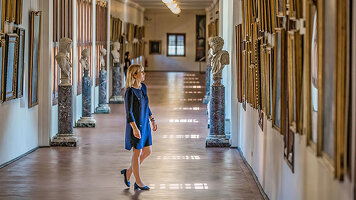
Viking are destination experts. With no casinos or children on board, you can be assured that the focus is firmly on enrichment and education. Read more

After a day of exploration or just to enhance the relaxation of a day at sea, the on-board Spa will leave you feeling recharged and revitalized. Read more

Viking offer eight on board dining options. Beer, wine and soft drinks are available with lunch and dinner at no additional charge of fee. Read more

Viking proudly includes all that you need and nothing you do not. A variety of features and services valued at $200 per person per day are standard inclusions in your cruise. Read more
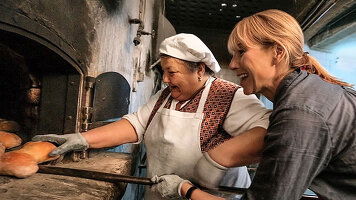
Viking include one complimentary shore excursion in every port of call. Enjoy exclusive entry to cultural treasures and seldom-seen collections around the world. Read more

Trip Reviews (4) Most Recent 'Antiquities of the Mediterranean' Reviews
Our 18-day Viking Cruise was good value for the price, but we had a few disappointments too. The itinerary already included quite a few sea days, but we ended up with even more than scheduled. We were unable to land at the Falkland Islands due to weather (wind and choppy seas), a huge disappointment as this was one of the main reasons we had chosen this cruise. Port Stanley has to be landed by ship’s tender, and we suspect that, had we been an expedition ship with fewer mobility limited passengers, that landing would have been feasible. Additionally, we had to return to Ushuaia 4 hours after departure to offload a medical emergency, meaning that we arrived in Punta Arenas too late in the day to go ashore and do any excursions. As a result, this cruise ended up with far too many sea days for our liking.
Having said that, the ship itself was beautiful, the 4 guest lecturers were knowledgeable and fascinating, the entertainment was excellent, the dining was delicious, and the staff were absolutely fabulous. Viking is certainly a company that prides itself on faultless service and they definitely delivered on that. The photo I am including is of the Perito Morino Glacier which we saw on our pre-cruise trip to Patagonia.
The optional excursions in each port were a little disappointing, not a lot to see ...read more or do in some of the ports and we had to use tender boats in most of the ports which was quite annoying. All in all though, a very good cruise, would definitely recommend doing a Viking cruise. Yvonne from Global Journeys organised our tour, she did a great job.
Brochure

Viking River, Ocean & Expedition Voyages (2025-27)
Dates & Pricing
 USD
USD
Viking Cruise $25 Deposits!
Cabin Layout Options:
Select Cabin Preference:
Tour & cruises prices are per person. Prices shown have savings applied, are subject to availability and may be withdrawn at any time without notice. Pricing and trip details are correct at this point in time, however are subject to confirmation at the time of booking and are subject to change by Viking. For cruise itineraries, cabin images are sourced from the cruise-line and should be treated as indicative only. Cabin inclusions, upholsteries and room layout may differ to the image(s) shown depending on the ship selected and your sailing dates.
